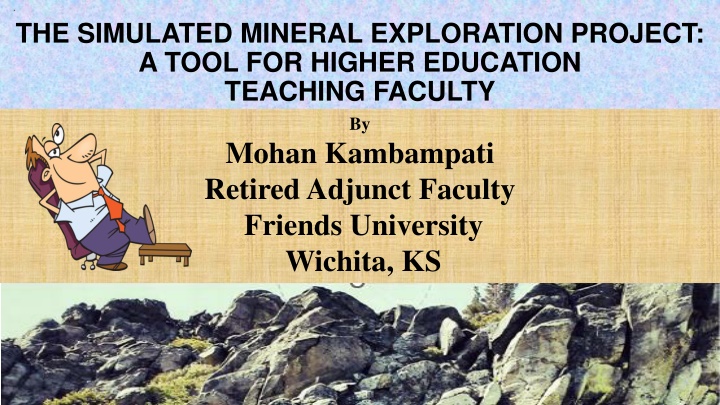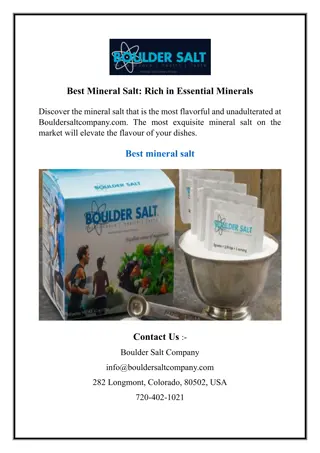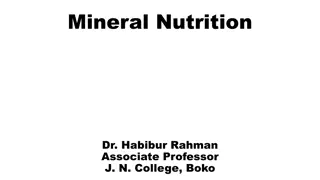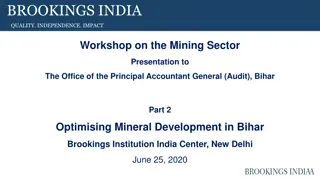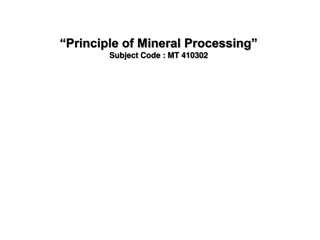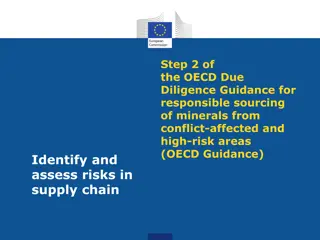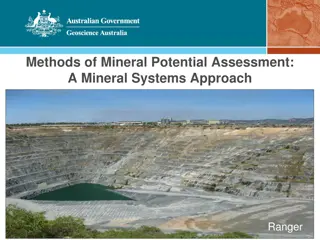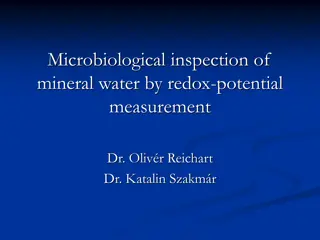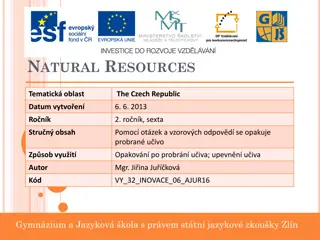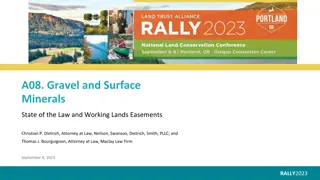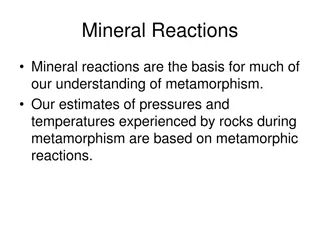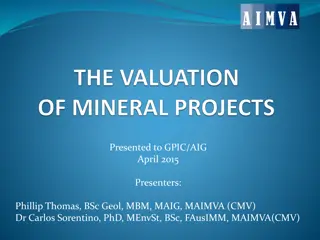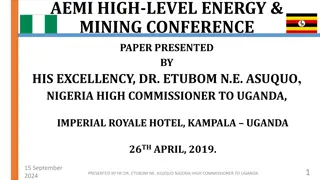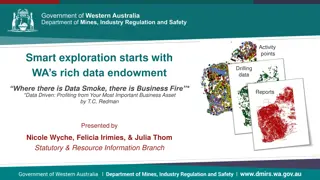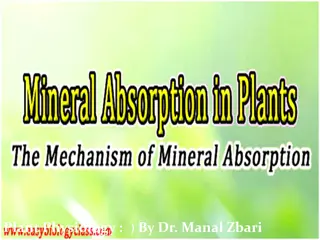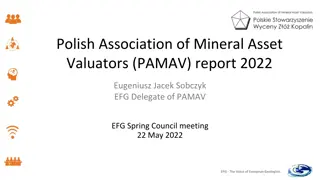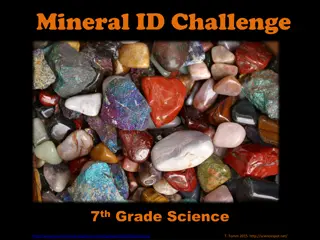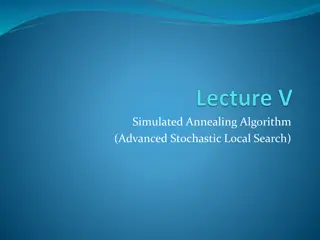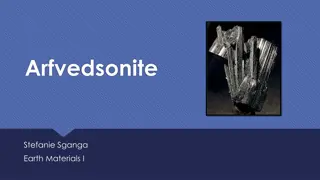Simulated Mineral Exploration Project: A Tool for Higher Education
This project delves into types of mineral deposits, the origin of ore deposits, Bowen's Reaction Series, magma production, the relationship between Bowen's Reaction Series and mineral exploration, and hydrothermal deposits. It emphasizes the importance of understanding mineral formation sequences in identifying valuable ores and discusses hydrothermal vein deposits.
Download Presentation

Please find below an Image/Link to download the presentation.
The content on the website is provided AS IS for your information and personal use only. It may not be sold, licensed, or shared on other websites without obtaining consent from the author.If you encounter any issues during the download, it is possible that the publisher has removed the file from their server.
You are allowed to download the files provided on this website for personal or commercial use, subject to the condition that they are used lawfully. All files are the property of their respective owners.
The content on the website is provided AS IS for your information and personal use only. It may not be sold, licensed, or shared on other websites without obtaining consent from the author.
E N D
Presentation Transcript
THE SIMULATED MINERAL EXPLORATION PROJECT: A TOOL FOR HIGHER EDUCATION TEACHING FACULTY By Mohan Kambampati Retired Adjunct Faculty Friends University Wichita, KS
TYPES OF MINERAL DEPOSITS 1. Metallic Resources or Ores (Ore may be defined as a naturally occurring metallic resource which can be profitably mined) 2. Energy Resources. Good examples are Uranium and Thorium deposits. Monzonite placer deposits are an important source of thorium which can be converted to uranium to use as an energy source
ORIGIN OF ORE DEPOSITS To understand the origin of ore deposits such as copper, lead, zinc, platinum and many more we must understand Bowen s Reaction Series (BRS)
WHERE MAGMA IS PRODUCED Magma is produced deep Within the earth s crust or upper mantle At these depths due to increased pressure and temperature partial melting of rocks take place generating magma. https://www.freepik.com/f ree-photos-
RELATIONSHIP BETWEEN THE BOWENS REACTION SERIES AND MINERAL EXPLORATION Understanding the sequence of mineral formation is vital for identifying ore deposits and non-ore economic mineral deposits. For ex, the earliest formed rocks (Ultramafic) are peridotite (intrusive) and komatiite (extrusive) Peridotite is the host for valuable ore deposits (platinum, chromite, nickel), and non-ore deposits (diamond, talc, chrysotile asbestos.)
HYDROTHERMAL DEPOSITS At the very end stage of BRS the remnant solutions (hydrothermal solutions are rich in ore minerals such as copper, zinc, tungsten, molybdenum) These solutions will intrude into the freshly formed granitic rocks and deposits mostly as veins Skarn and porphyry deposits are formed by replacement reactions of country rocks by ore bearing hydrothermal solutions. These are normally low grade but quantity of ore available is high.
HYDROTHERMAL (VEIN) DEPOSITS These are formed at the end stage of BRS Mineralization occurs as different sizes of veins and patches ------------------------------------------------------------------------------ Thus, an exploration geologist working for platinum or chromite will explore in peridotite (the earliest stage of BRS) and for copper and other base metals in hydrothermal skarn or porphyry deposits and granitic rocks (later stages of BRS)
OTHER TYPES OF MINERAL DEPOSITS Placer deposits Metamorphic mineral deposits Bedded and layered deposits Skarn and porphyry deposits
WHAT IS MINERAL EXPLORATION? Mineral exploration is the method of finding minable mineral deposits in the ground or to examine possibilities of such mineralization in the ground. If the target is to find platinum or chromite deposits the search(exploration) should be confined to ultramafic rocks. If the target is to find copper or other base metals one would explore the host rocks of hydrothermal deposits.
STEPS OF TARGET GENERATION Let us say the exploration is for copper 1.Initial exploration begins with appraisal of known copper bearing areas. 2.Appropriate maps are to be studied. These will be available from government agencies such as geological surveys, libraries, universities, and others. 3.If previous exploration was conducted in the area, their reports are to be examined, if available. Once considered uneconomic and abandoned areas may now be targets of exploration.
STEPS OF TARGET GENERATION (2) CONTD 4. Detailed exploration mapping must be conducted, paying attention to gossan (severely oxidized sulfide deposits below the ground), leached and enriched jones, to examine possibilities of exploitable mineralization in the ground. 5. Aerial photos/ satellite images are to be studied. 6. Preliminary geophysical and geochemical surveys are to be conducted.
SURFACE EXPLORATION Same data may be viewed differently by different exploration agencies and with change of time. An area, what was considered unexplorable and discarded may be a good target for exploration due to changed economic conditions and new exploration techniques. So, the target area that has been determined needs further surface exploration to build more confidence. This is accomplished through detailed geophysical and geochemical surveys. However, we still cannot see the ore.
SECTION 2: SIMULATION OF MINERAL EXPLORATION Mineral Exploration has taken an important role because of depletion of shallow mineral deposits and increased demand So far, we discussed the prelude to this section. In regular classrooms the chapter on mineral exploration may stop there. But in the real world there is more to exploration. The ultimate goal of exploration is to determine how much ore is there under the ground and the grade of that ore. In this section we will examine the following topics: - Core Drilling. - Core sampling weighted average. - Reserve calculation.
CORE DRILLING As they say, seeing is believing. Geophysical and Geochemical prospecting only indicates the possibilities of mineralization. They give an idea of the depth and width of the mineralization. Only drilling, through the rock, exhibits the mineralization, it s nature and form. Drilling is the only tool to define the outlines of the ore deposit and reserve estimation.
CORE/DIAMOND DRILLING The Drill bit is attached to the drill barrel. The bit rotates at a high-speed cutting the rock as it goes deeper and deeper. The drilled core enters the barrel. Due to the friction the bit gets very hot. Water is sent into the cutting surface to cool the bit. For softer rocks, where a core is not needed diamond drilling is not used. The geologist, based on the 6 steps mentioned under target generation in the first section, will locate the initial drill site on the ground.
MORE ABOUT DIAMOND DRILLING (2)contd Drilling progresses, drill crew drills 4 to 6 ft, brings core barrel to the surface, and core is retrieved from the barrel. The drilled cores are stored in core boxes. Geologist logs the core noting the rock formations, and any other structural features. At places, instead of solid core, rock fragments may be recovered, which indicate structural changes or fault zones of the formation. As the anticipated depth of ore zone approaches, geologist gets doubly careful to obtain and records many details as s/he observes.
CORE SAMPLING WEIGHTED AVERAGE OF MINERALIZATION The mineralized core must be split into half by core splitter. One half is preserved for future records. The other half is marked out into different samples by visual estimation of the intensity of mineralization. These samples are crushed and sent to a laboratory for assaying. Depending on the concentration of mineralization, sample length will vary.
WEIGHTED AVERAGE Suppose a set of values have different weights (mineral percent) the weighted average is to be calculated with the given formula. The weighted average of the ore zone, in our example copper mineralization, must be calculated Weighted Average = (Sum of sample widths times weight) divided by (sum of weights) The following table and follow up notes explain the process
DATA TO CALCULATE WEIGHTED AVERAGE SAMPLE # WIDTH OF SAMPLES WIDTH TIMES WEIGHTS COPPER % OF SAMPLES IN INCHES ( WEIGHT ) 1 2 3 4 5 1.5 4.0 0.5 0.5 0.5 0.8 7.0 2.0 0.7 0.5 1.20 28.00 1.00 0.35 0.25 7.00 11.0 30.80
WEIGHTED AVERAGE EXAMPLE Weighted Average = Sum of sample width times weight (Copper percentage) (1.5)(0.8)+(4.0)(7.0)+(0.5)(2.0)+(0.5)(0.7)+(0.5)(0.5) = 30.80 Sum of weight (copper percentage) (w) = 11 (30.80) (11) = 2.8% copper
SUBSEQUENT BOREHOLES Based on the weighted average and from his detailed geological mapping the geologist will determine the location of subsequent bore holes. In hydrothermal vein deposits when to stop drilling a hole is difficult to decide because after a small interval of barren rock mineralization may show up again. Mineralization plays hide and seek.
RESERVE CALCULATION There are many reserve calculation methods. Some of them are polygonal, triangle, inverse distance, cross section, and geostatistical methods and by utilizing different software packages. Estimation of ore reserve may be explained as determining the quantity of economic ore mineral present in the ore. In fact, determining grade and thickness of the ore body is part of ore reserve estimation.
THE SIMULATION For our simulation purpose let us consider hydrothermal type of copper deposits. Hydrothermal deposits are more common and difficult to sample the ore zones because of their erratic nature of deposition. A map roller portrays a drill core. I logged the core that came out of a bore hole and observed mineralization of different intensities. I split the core into two halves. On one half I demarcated different lengths of samples based on the degree of intensity of mineralization. They were crushed separately and dispatched to a laboratory for analysis of copper. The weighted average of the mineralized zone in this bore hole is calculated
DATA TO CALCULATE RESERVES Sample width in inches ("weight") 1.5 4.0 0.5 0.5 0.5 Sample number Copper % Width times "weight" 1 2 3 4 5 0.80 7.00 2.00 0.70 0.50 1.20 28.00 1.00 0.35 0.25 7.00 11.00 30.80
ORE RESERVE ESTIMATION IN THE EXAMPLE To calculate the ore reserve, the following factors are assumed 1.Three more hypothetical bore holes are considered. (dotted section is mineralized zone) 2. Widths of the samples and copper percentages are assumed for additional boreholes.
ORE RESERVE CALCULATION contd 3. Another assumption is that the width of ore zone extends halfway to the next hole which is considered as a block. The volume of each block is calculated by the end-area formula. This volume is divided by volume-per-ton factor to get consolidated ore reserve.
SECTION 3: PROJECT- BASED TEACHING (PBT) AND PROJECT - BASED LEARNING (PBL) PBT is a method which enables students to think critically and collaborate with their peers and solve problems and challenges in their academic work. PBL is student centered method that involves students in real world projects. PBL students acquire 21st century competencies: Critical thinking, collaboration, creativity and independent learning PBL ha a profound impact on college and career readiness In geology in many instances PBT and PBL will take place.
ACKNOWLEDGEMENTS I thank you all for attending this presentation. I thank the sponsors of this conference, Kaleidoscope Learning, for giving me the opportunity to present this paper. I appreciate the conference planning team who answered my many questions promptly. That was a big help.
